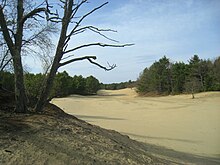Desert of Maine
The Desert of Maine ( de .: Desert of Maine ) is an inland dune landscape in the US state of Maine . It is located about four kilometers west of downtown Freeport ( Cumberland County ) in a pine forest .
history
In 1797 (or 1783) William Tuttle and his family moved to what was then just under 121 hectares of farmland. At first, potatoes were grown there very successfully , hay was harvested and cattle were kept . Subsequent generations also owned sheep to sell their wool to weaving mills . However, errors in crop rotation combined with massive deforestation and overgrazing led to increasing soil erosion after a few decades , which exposed sand deposits. It is sand and silt that have been there since the end of the last glaciation phase of the Pleistocene Ice Age around 10,000 years ago. At that time, the region's glaciers first cut larger stones into gravel and later into even finer-grained materials that are up to 25 meters deep. In the course of time, these isolated small spots widened, strong northwest wind formed dunes and drove the sand on and on, until finally an initially irreversible desertification set in. Initially, the Tuttles considered using the sand to make bricks and in this way build a new foothold, but the high mica content prevented the stones from being stable. In 1919 the family was therefore ultimately forced to give up the farm for good.
Henry Goldrup († 1976), the alleged inventor of the bumper sticker , bought the land for 300 US dollars and converted it to 1925 into a tourist attraction to. Over time, the farm buildings were blown into the sand. The same fate befell a pump house built in 1935 , which was completely swallowed in 1962 and in 2006 lay under a 2.5 meter thick sand cover. After Goldrup's death, his wife Elizabeth could no longer manage the site herself. After it had been on sale for two years, it was bought by the Californian Ronald Dobson and his family in the early summer of 1982 .
The Desert of Maine is now a well-known travel and excursion destination beyond state borders and has almost 30,000 visitors annually. In order to preserve them as a natural curiosity with dunes up to 18 meters high, attempts are made, among other things, with strong clearings to prevent overgrowth caused by littering fauna. Nevertheless, the desert has already lost a large part of its original size since its disclosure and currently only measures around 16 hectares.
Individual evidence
- ↑ Maura J. Casey: "The Little Desert That Grew in Maine" ( Memento of the original from March 11, 2007 in the Internet Archive ) Info: The archive link was inserted automatically and has not yet been checked. Please check the original and archive link according to the instructions and then remove this notice. on travel2.nytimes.com ( The New York Times ), September 22, 2006
- ↑ William Cockerham: " 'Desert of Maine' gobbles buildings, stumps geologists" in Anchorage Daily News , 1 August 1982, I-11
Web links
Coordinates: 43 ° 51 '31.4 " N , 70 ° 9' 23.6" W.
